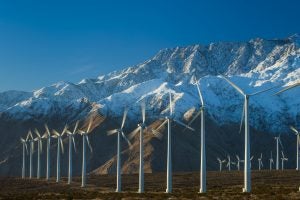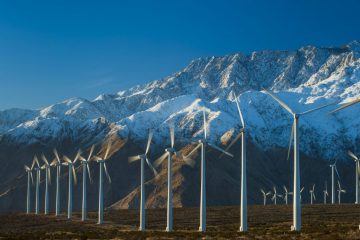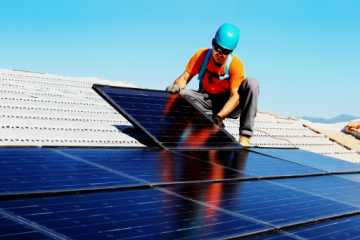The Future is California – How the State is Charting a Path Forward on Clean Energy
 The late California historian Kevin Starr once wrote, “California had long since become one of the prisms through which the American people, for better and for worse, could glimpse their future.” These words have never felt truer. Just ask Gov. Jerry Brown or the leaders of the state legislature, who are all issuing various calls to action to protect and further the state’s leading climate and energy policies.
The late California historian Kevin Starr once wrote, “California had long since become one of the prisms through which the American people, for better and for worse, could glimpse their future.” These words have never felt truer. Just ask Gov. Jerry Brown or the leaders of the state legislature, who are all issuing various calls to action to protect and further the state’s leading climate and energy policies.
California is the sixth largest economy in the world and the most populous state in the nation. What’s more, we’ve shown that strong climate and energy policy is possible while building a dynamic economy. We’ve proved that clean energy creates far more jobs than fossil fuels – nationwide, more than 400,000, compared with 50,000 coal mining jobs – while protecting the natural world for all people.
It’s no shock our leaders are fired up. There’s too much at stake. With our state’s diverse, booming yet unequal economy, we are not unlike the rest of the nation. State-level leadership is more important than ever, and other states can and should learn from California to drive action across the U.S.
A case study in a clean energy economy
Business and economic growth relies, in part, on certainty and a long-term view. That’s why electric fleet-firm Proterra announced it would manufacture its buses just outside Los Angeles – it understands its market is on the West Coast. Proterra is only the most recent of a long list of firms that understand California’s environmental policies provide market opportunities.
Silicon Valley titans like Google, Apple, and Facebook are all are well on their way to meeting internal commitments to 100 percent renewable energy. And California was recently ranked among the top five states for corporations that seek to buy or build renewable energy generation – attracting job-creating enterprises.
Importantly, clean energy is sparking businesses of all sizes. A new report highlights how the state’s long-standing energy efficiency requirements have helped create 300,000 jobs in energy efficiency – most coming from small firms.
What to watch in California
These are just a few examples of how forward-thinking policy – including the state’s 2030 climate targets and 50 percent renewable portfolio standard – are shaping markets, creating jobs, and stimulating economic growth. Citizens are demanding strong policy as clean energy technologies from LEDs, to smart thermostats, to rooftop solar continue to fall in costs.
Thus, California leadership is looking ahead to the clean energy frontier while also defending what we have. The three themes that guide where we are heading broadly center around effectively integrating cost-effective renewables, capitalizing on the potential of distributed energy resources, and making sure those advancements are accessible to all Californians. As more states make clean energy growth critical to economic and social progress, including the success of wind power in Texas, the recent bipartisan legislative victory in Illinois, and New York’s overhaul of their energy sector, it’s apparent that progress is catching on.
Integrating renewables to shape a clean, reliable grid
Although California is not new to enacting policies aimed at integrating renewables onto the grid, it remains paramount. Recent analysis suggests we are two years ahead of schedule in terms of hitting energy-load predictions associated with the amount and speed of California’s solar growth, illustrated by the infamous . This is, no doubt, a good problem to have. However, the growth and cost competitiveness of renewables are making ever more pressing the challenge of meeting steep afternoon ramps in energy demand – when Californians come home and switch on their lights and appliances.
We are two years ahead of schedule in terms of hitting energy-load predictions associated with the amount and speed of solar growth.”
The state has worked to tackle renewables integration challenges from multiple fronts. Regulators passed rules to incentivize energy storage. Successful and smart design of time-of-use rates has the potential to shift energy load, and drive customers to consume electricity when it’s cheapest and cleanest. Additionally, the push to create a western-wide electric market is in large part due to the need to find new markets for California’s cheap, wasted solar, and to bring in cost-effective renewables from other western states when Californians need it most.
Moreover, a recent study by the California Independent System Operator (CAISO) showed that large-scale solar coupled with the right set of inverter technologies can transform renewables into grid resources that meet ramping and reliability needs. First and foremost, the key will be to extend our fantastic midday solar to serve energy demand throughout the day using clean energy strategies and incentives.
Optimizing distributed energy resources
California leads the nation in many indicators of distributed energy resources from the most advanced meters to solar installation. However, ensuring the positive impact of these clean resources reaches the grid is where the rubber hits the road. This will include mapping out and structuring markets so distributed energy resources, like battery storage, can provide cost-effective power where it is most beneficial to help offset the need for future generation capacity.
Thankfully, bolstered by California’s leading clean tech industry, the state is already testing market reforms and demonstrations to prove the potential of these distributed resources. Here are a few examples:
- This past summer, the three major utilities in the state contracted 82 MW in demand response from the Demand Response Auction Mechanism, a cutting-edge market vehicle for residential demand response.
- Market reform is also happening through aggregation. The CAISO, which controls much of the state’s grid, received approval for a framework in which smaller distributed energy resources can meet reliability needs at the wholesale level when grouped together.
- The Department of Defense is funding the largest “vehicle-to-grid” demonstration project in the world at the Los Angeles Air Force Base to test the potential of two-way power sources like electric vehicle batteries. The aim is to determine whether the Defense Department’s fleet of electric vehicles can reliably provide power back to CAISO during times of peak demand.
As we look to further capitalize on the flexibility and affordability of distributed energy resources in forums like the major utilities’ long-term procurement planning processes, it will be critical to continue to push the tools that do the following: use methods like aggregation, use resources like two-way power, take location into account, and rethink the utility business model.
Ensuring success reaches all communities
California, through the SB 350 Barriers Study, is also examining how clean energy can spur growth in low-income and disadvantaged communities across the state. This signals that the state realizes that in order to achieve our energy goals we need to ensure clean energy resources are accessible to all communities. Despite big economic gains, the state continues to grapple with near 20 percent poverty. In both urban and rural regions there are high percentages of renters and seniors, who may not have the financial capital or live in physical environments suitable for investing in clean energy. These barriers make solutions like rooftop solar, high efficiency appliances, and household storage just out of reach.
The state has shown a good track record of protecting burdened communities from further environmental harm and incentivizing job-creating clean energy. However, the robust, far-ranging set of recommendations in the Barriers Study provides a source of inspiration and acknowledgement that we need to do more.
Our state is a multi-faceted economy, built on a diversity of people, politics, and industries, and defined by wealth, poverty, and millions of hardworking Americans – just like the rest of the country. We invite states in regions from the Pacific Northwest to the Mississippi Delta to learn from California’s success, and the challenges.






 President Trump’s
President Trump’s 